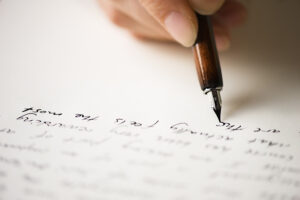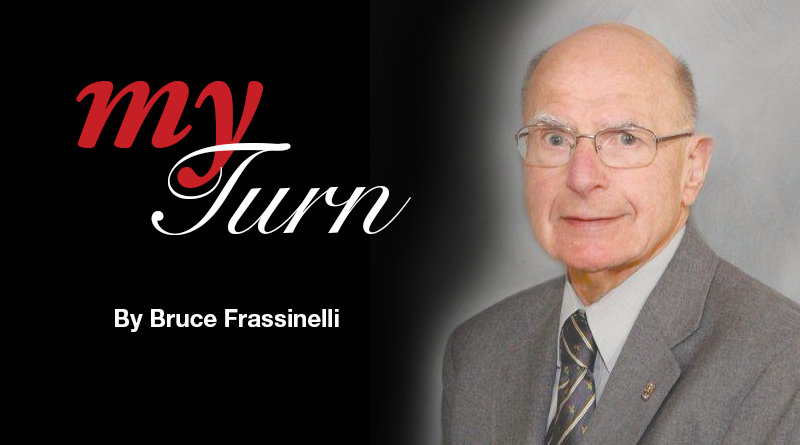Penmanship and Note-writing
By Bruce Frassinelli Email: bfrassinelli@ptd.net
 When I was in elementary school, our desks had an inkwell at the upper right corner, and from time to time we used a fountain pen that we dipped into it to practice our penmanship.
When I was in elementary school, our desks had an inkwell at the upper right corner, and from time to time we used a fountain pen that we dipped into it to practice our penmanship.
Although I was a straight A student, my penmanship was notoriously lousy, leading me to grades of 77 or 78 each marking period while getting 95s or higher in major subjects.
Once a week, we practiced penmanship using the Palmer Method booklet as our guide. We made elaborate curliques as well as capital and small letters. We printed and used cursive letters of the alphabet. These were tedious exercises, because we would constantly be reinserting our pens into the inkwells.
The Palmer Method was developed in the late-19th and early-20th centuries by Austin Palmer, an Iowa educator and handwriting teacher. It was hailed as a simplified version of the overly flowery Spencerian Method, which had been the standard handwriting method since the 1840s.
Palmer Method proponents preferred its speed and plainness over the laborious Spencerian Method and said that it allowed the writer to compete with the speed of a typewriter.
Educators embraced the Palmer Method, claiming that it would be useful in schools to reinforce regimentation, improve discipline and character, even reform delinquents. Under the Palmer Method, we were taught how to adopt a uniform system of cursive writing emphasized by rhythmic motions.
Because of the frequent number of times that we dipped our pens into the inkwell, it was common for some of the ink to get on our fingers and hands, but God forbid if we got it on our clothing. There would be hell to pay when I got home and tried to explain my carelessness to mom.
The Palmer Method began to fall out of favor in the 1950s and was ultimately replaced by the Zaner-Bloser Method which encouraged children to use print or manuscript writing. This was a prelude to their being taught cursive writing. It is ironic that cursive writing is today a lost art among many youngsters, although in some schools it is making a comeback.
My teacher, Alberta Ohl, joked that with my poor penmanship I would probably wind up being a doctor since they presumably are notorious for their unidentifiable signature scrawls.
My youngest son, Paul, who is a general surgeon in South Carolina, fits the stereotype. When he signs his last name, it looks like an “F” followed by a straight line.
It was a wake-up call for me earlier this year when my niece told me that her daughter could not read my birthday wishes that accompanied the card I sent her. Yes, I am one of those rare birds who still send hand-written greeting cards, mostly greeting and thank you notes. It brought back memories of my mother telling me to sit at the kitchen table and write a thank you to Aunt Rina and other relatives who sent me birthday gifts.
As for my niece’s daughter, I immediately thought her inability to read my note had something to do with my sloppy handwriting, but, no, it was because I had written it in cursive rather than printed it. I thought to myself, “Gee, my note had to be translated by a third party as if it were a foreign language.”
I subsequently learned that this was not unusual: Many school-age children no longer learn cursive writing as part of their education. My mind went kaflooey wondering how these children would function in a modern society without knowing cursive. “Just fine,” the answer appears to be.
But what about signing a check? I am told that most children might learn how to sign their own name in the event that an archaic need such as check-cashing arises, but even there we have many technical alternatives. I have stopped sending checks to my grandchildren and younger relatives, because they languish uncashed for months for any number of reasons. I sent a $25 check to my granddaughter on Jan. 1 for making the Dean’s List during the fall 2022 semester. She cashed it on June 2.
Now, banks allow us to move money from one account to another instantly without a paper check, and there’s never a need to visit the physical bank. Then there is Venmo and other alternatives to traditional bank accounts.
Some of my generation are furious that cursive is going the way of the horse and buggy. I wonder why. I have come to terms with it. Just because I was brought up with cursive writing is no reason to demand that it should be imposed on a younger generation if it has outlived its usefulness.
Some have compared the demise of cursive writing to the death of the slide rule and abacus. With the birth and proliferation of calculators, the slide rule became a relic of another age, not instantly, but in a relatively short period of time. I remember when calculators first became popular that teachers forbade students to use them in class to force them to use manual applications. Why, I wondered. What a fantastic tool!
With the almost universality of keyboarding, the need for cursive has similarly become antiquated. Sure, it’s a burden for me to print a birthday or Christmas note of some length to one of my younger relatives, so I have turned to alternatives — texting and emailing.
Quite frankly, they quickly skim over the greetings on the accompanying card anyway. It’s my message that counts, even more so the money gift included in any fashion except by check. Cash seems to be most appreciated. As one of my granddaughters put it, Franklin and Grant are her favorites. (Ben Franklin is on the $100 bill, and Ulysses S. Grant is on the $50 bill.)
By the way, even the U.S. Postal Service has weighed in on the issue and says that it prefers typed or computer-generated addresses. If we must manually write the address, it suggests that we use block letters for easier comprehension.
I am sure that I will get a lot of pushback about my views on this subject, but I see the writing on the wall so to speak: Curses on cursive. It’s time to retire the teaching of cursive, assuming it is still out there. There are more important things to teach and worry about. I assure you that all of us will survive.

